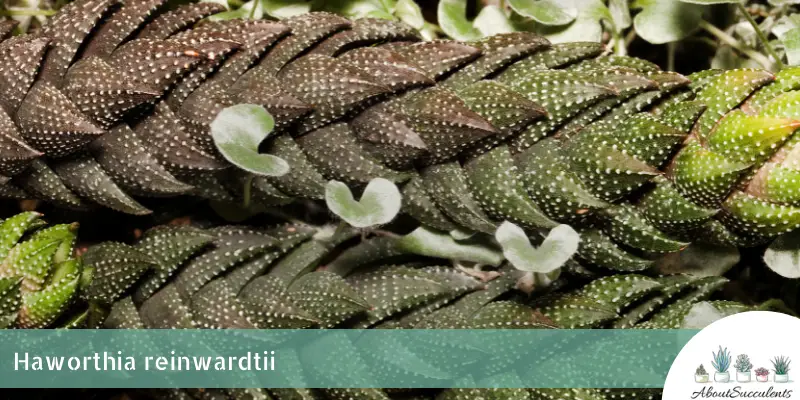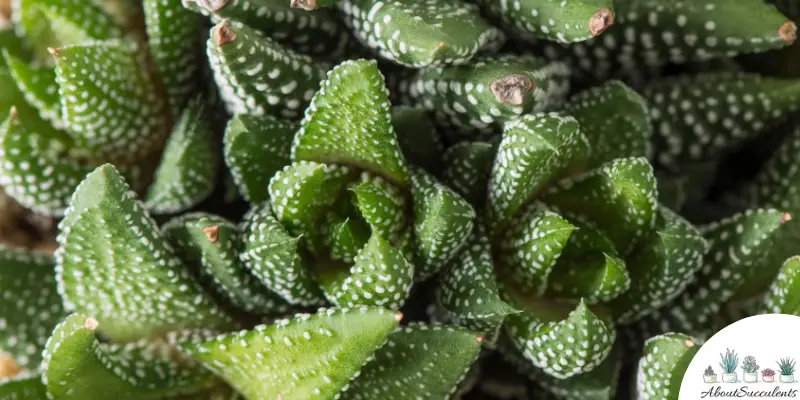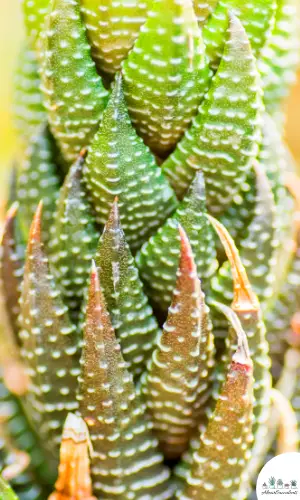
Haworthia reinwardtii is identified by its elongated rosettes made up of thick leaves speckled with distinct white spots that give the succulent plant its alias “Zebra Wart”. Another nickname for Haworthia reinwardtii is African Pearls.
You might come across garden shops selling this plant as Haworthiopsis reinwardtii, its leaves can appear in a variety of colors from deep red to lush green. If you prefer a darker shade of red such as maroon, expose the succulent plant to more sunlight..
Zebra Wart comes across as odd or unusual-looking but in a beautiful way. Fully-grown Haworthia reinwardtii can reach a height of 20cm (8”) and will definitely be a captivating and provocative addition to any home or garden.
Haworthia reinwardtii is native to the Eastern Cape province of South Africa and is a member of the Asphodelaceae family.
General Information:
Also known as: Zebra Wart, African Pearls
Plant Family: Asphodelaceae
Origin: Eastern Cape province of South Africa
Height: 20cm (8”)
Exposure: Partial or indirect morning sun for 6 hours
Water Needs: Only water the soil when it has completely dried out.
Soil Type: Standard soil potting mix with peat moss and sand to improve drainage.
Soil pH: 3.9 to 7.8
How to Grow and Care for Haworthia Reinwardtii

As a small, clumping plant with bizarre-but-beautiful leaves that spiral upwards, Haworthia reinwardtii is the ideal succulent to grow in the garden or indoors.
Zebra Wart can pass as plant life from another planet and will surely trigger interesting conversations among your guests.
If you want to have this succulent in your home or garden, the great news is that it’s very easy to grow and care for.
Sunlight
Haworthia reinwardtii needs to receive a good amount of sunlight to thrive. If you prefer Zebra Wart as an accent to your outdoor garden, make sure it gets 4 to 6 hours for partial morning sun every day.
Avoid garden locations that expose Zebra Wart to the scorching heat of the afternoon sun as the leaves can get sunburned.
As an indoor plant, place Haworthia reinwardtii near a window that receives 4 to 6 hours of indirect sunlight every day. If the room isn’t getting enough sunlight, place African Pearls under a Grow Light.
This isn’t a cold-hardy type of succulent plant. If the temperature of your region drops below 4.5° C (40° F), it would be best to move Haworthia reinwardtii indoors.
Watering

When it comes to watering succulent plants, neglect is best. Haworthia reinwardtii grows better when it receives less water. You can water Zebra Wart once a month, and the plant will be happier for it.
Overwatering Haworthia reinwardtii will keep its roots in a moistened environment for an extended period. The consequence is that the roots will rot and put your plant at the risk of developing a fungal infection.
To find out if it’s time to water the plant, insert a stick into the soil. Now, check the stick by feeling its end. Does it feel dry to your touch? If so, give the soil – not the plant – a thorough soaking.
Cut down the watering schedule during the colder months because the soil will stay moist longer.
Pot and Soil
When choosing a pot for Haworthia reinwardtii, the number one thing to keep in mind is drainage. The pot must have a drain hole with a mesh cover to let excess water come out without losing too much soil.
Terracotta and ceramic are the best materials to select for your pot as they allow moisture to naturally escape and evaporate from the soil.
A standard soil potting mix with the addition of ingredients such as peat moss and sand will provide Zebra Wart the best conditions to support growth.
If you want to transfer Haworthia reinwardtii, choose a larger pot to give the longer roots more space and for air to circulate properly in the soil.
How to Propagate Haworthia Reinwardtii
Haworthia reinwardtii is also popular with horticulturists because it’s very easy to propagate. You can add to your number of Zebra Wart with 3 methods: Leaf Cuttings, Offsets, or Seeds.
Method 1: Leaf Cuttings
Step 1: Choose a healthy leaf from the stem.
Step 2: Cut the leaf with a sterilized and sharpened pair of garden shears or perform a clean twist and pull off the leaf from the stem. To guarantee successful propagation, no part of the leaf must be left on the stem.
Step 3: Allow the leaf cuttings to develop hard calluses over 2-3 days. The best location for the leaves to dry out would be a warm area.
Step 4: Place the hardened leaf cuttings on top of well-draining soil.
Step 5: Only mist the soil and do so when it’s completely dry.
Method 2: Offsets
Step 1: Gently pull out the offsets that are growing from the base of the main plant.
Step 2: Find a warm and dry location and allow the offsets to dry out and develop calluses.
Step 3: Place the offsets on top of well-draining soil.
Step 4: Water the soil only if it’s properly dried out.
Method 3: Seeds
Step 1: Plant the seeds in pre-moistened, well-draining soil.
Step 2: Cover the soil with plastic and place it in an area that receives partial sunlight to allow proper germination.
Step 3: After a few weeks, you should see a few seeds begin to sprout. Remove the plastic and water the soil only when it’s 100% dry.
Frequently Asked Questions
Is Haworthia Reinwardtii Toxic to Cats and Dogs?
You won’t find Haworthia reinwardtii on the list of plants that are toxic to cats and dogs on the website of the American Society for the Prevention of Cruelty to Animals (ASPCA).
Why Is My Haworthia Reinwardtii Dying?
Are you worried that your Haworthia reinwardtii is dying because you notice signs of weakness? The possible causes of death might be either overwatering or pest infestation.
Overwatering
If you think Zebra Wart is like any other plant that you shower love by giving it more water, think again. Overwatering is the leading cause of death for succulent plants, Haworthia reinwardtii included.
Keeping the roots in a moistened state increases the chances of rotting. When the roots rot the next stage will be a fungal infection that can quickly spread throughout the plant.
If you see the leaves turning blackish brown or yellow, cut them off with a sterilized pair of garden shears right away. The same goes for any part of the stem.
From there, remove the plant from the soil and cut off rotting roots. Prepare Zebra Wart for repotting by letting it dry in a warm area.
Fill a new pot with well-draining standard potting soil mix and replant Haworthia reinwardtii.
Pest Infestation
Typical of most succulent plants, Haworthia reinwardtii might look inviting to sap-drinking insects such as mealybugs, aphids, and spider mites.
You can keep these disease-causing pests by spraying the plant with neem oil. If you notice white, cotton-like substances on its leaves, Zebra Wart might have mealybugs as unwanted tenants.
Wipe the white substances out with 70% isopropyl alcohol or with a mild insecticide soap.
Does Haworthia Reinwardtii Produce Flowers?
Yes, Haworthia reinwardtii produces pinkish-white flowers with a tubular shape in the spring. The flowers don’t have a scent.
Last Updated on June 9, 2022 by Sofia Lara